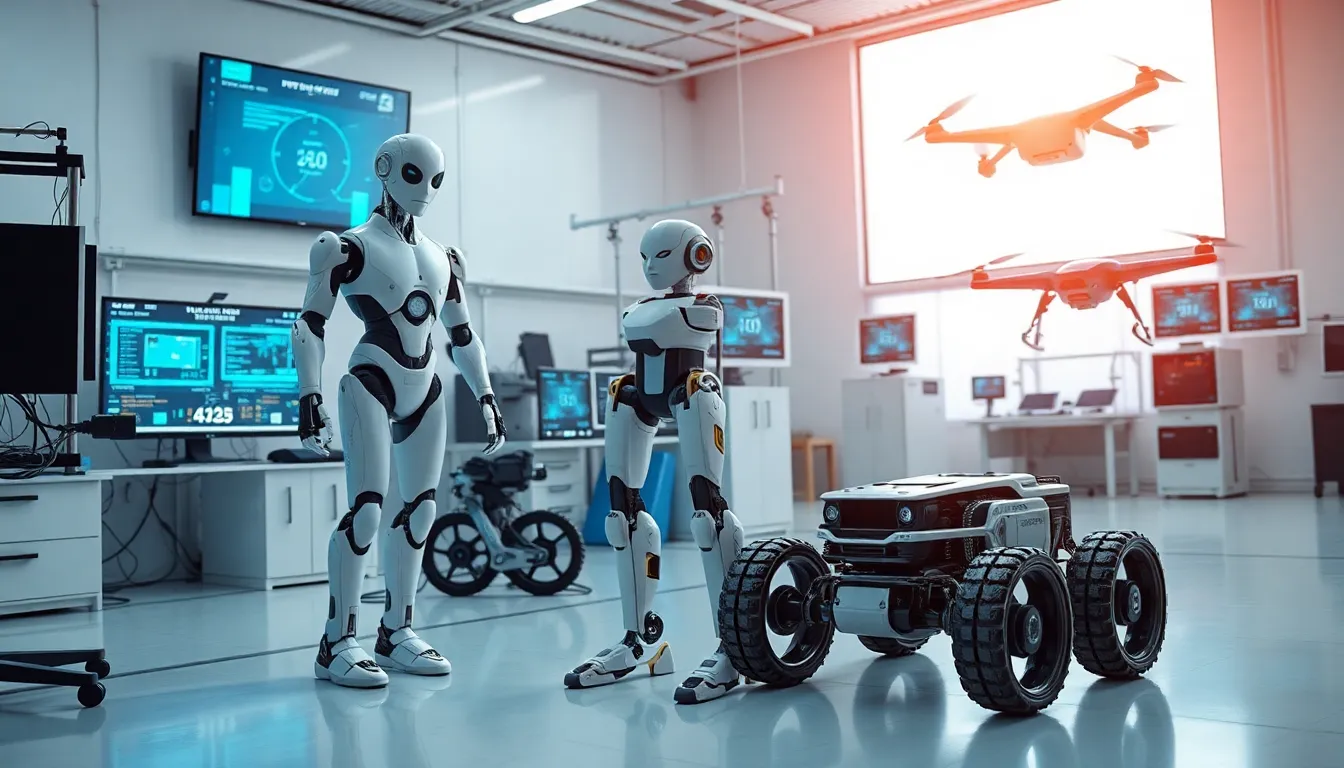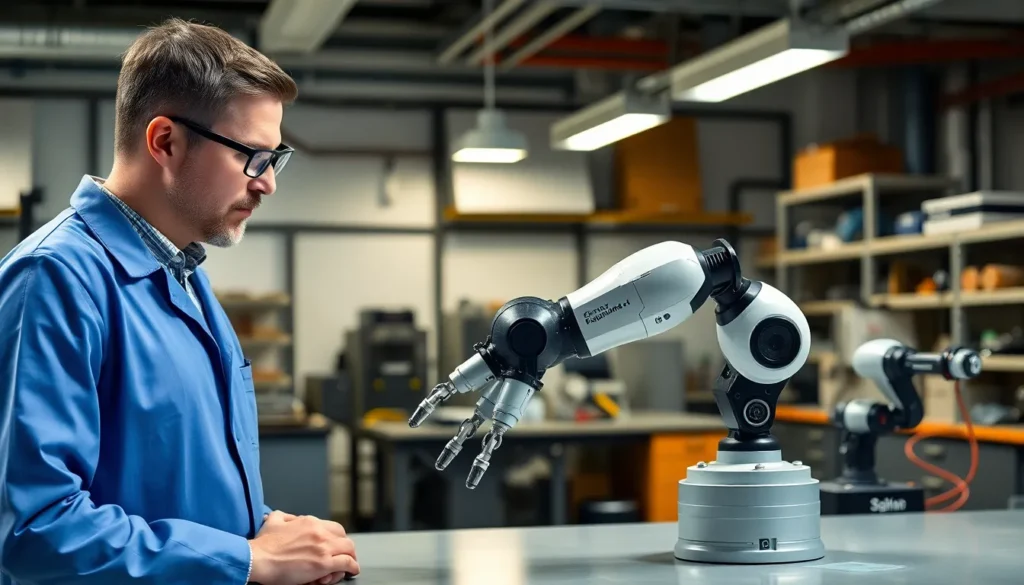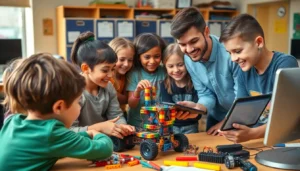Table of Contents
ToggleIn recent years, tech robotics innovations have transformed industries and everyday life in ways once thought impossible. From autonomous vehicles to advanced manufacturing robots, these breakthroughs are reshaping how humans interact with machines. As technology evolves, the potential for robotics to enhance efficiency and productivity continues to expand.
These innovations aren’t just limited to industrial applications. Robotics is making significant strides in healthcare, agriculture, and even home automation. With each new development, the line between science fiction and reality blurs, opening doors to possibilities that can improve quality of life and drive economic growth. Exploring these advancements reveals a fascinating landscape where creativity meets cutting-edge technology, paving the way for a smarter future.
Overview of Tech Robotics Innovations
Tech robotics innovations play a crucial role in transforming industries and enhancing daily life. Innovations such as autonomous vehicles and manufacturing robots significantly improve efficiency and productivity. Autonomous vehicles, equipped with advanced sensors and AI algorithms, navigate roads without human intervention, promoting safer transportation. Manufacturing robots streamline production processes; they execute tasks with precision, increasing output and reducing operational costs.
Healthcare robotics is another crucial area of advancement. Robotic surgical systems offer surgeons enhanced control and accuracy during operations, leading to better patient outcomes. Robotics in rehabilitation assists individuals in regaining mobility, showcasing the technology’s impact on improving quality of life.
Agricultural robotics revolutionizes farming practices. Drones monitor crop health and optimize resource usage, helping farmers increase yield while minimizing environmental impact. Automated tractors and harvesters reduce labor costs and enhance efficiency, making agriculture more sustainable.
Home automation robots simplify everyday tasks, boosting convenience. Smart vacuum cleaners, lawn mowers, and kitchen assistants enhance living spaces, reflecting the growing integration of robotics into household routines.
The convergence of creativity and technology shapes a future where tech robotics continuously evolve. These innovations not only redefine productivity but also contribute to economic growth, illustrating their importance across various sectors.
Key Innovations in Robotics

Recent innovations in robotics highlight advancements that push the boundaries of efficiency and capability. These key innovations include artificial intelligence integration, enhanced sensor technologies, and advanced mobility solutions.
Artificial Intelligence Integration
Artificial intelligence (AI) transforms robotics by enabling machines to learn from data and adapt to dynamic environments. AI algorithms enhance decision-making processes, empowering robots to execute complex tasks autonomously. Examples include robots in healthcare that analyze patient data for improved diagnostics and robots in manufacturing that optimize production schedules based on real-time data analysis.
Enhanced Sensor Technologies
Enhanced sensor technologies significantly improve robot functionality and safety. Advanced sensors, such as LIDAR, cameras, and accelerometers, allow robots to perceive their surroundings with high accuracy. These sensors enable navigation in unpredictable environments, paving the way for autonomous systems in as many areas as autonomous vehicles and warehouse automation. Robots equipped with superior sensors can detect obstacles, recognize objects, and measure distances, enhancing overall performance and reliability.
Advanced Mobility Solutions
Advanced mobility solutions include innovations that enable robots to maneuver effectively in various terrains and environments. Developments such as robotic legs, wheels, and treads provide versatility. For instance, drones equipped with the latest propulsion systems can achieve extended flight times and enhanced stability, while ground robots can adapt to uneven surfaces with improved suspension systems. These solutions expand the applications of robotics in sectors such as search and rescue and environmental monitoring.
Applications of Robotics Innovations
Robotics innovations span various sectors, significantly enhancing efficiency, safety, and quality of life. Key applications include manufacturing, healthcare, and personal assistance.
Manufacturing and Automation
Manufacturing and automation benefit from advanced robotics through increased precision and productivity. Industrial robots perform tasks such as welding, painting, and assembly, reducing production time and minimizing human error. The implementation of collaborative robots, or cobots, allows humans and machines to work safely alongside each other, boosting workplace efficiency. According to a report from the International Federation of Robotics, global robot installations in manufacturing reached over 2.7 million units in 2021, illustrating the industry’s rapid adoption.
Healthcare and Rehabilitation
Healthcare and rehabilitation utilize robotics to improve patient outcomes and streamline surgical procedures. Robotic surgical systems provide minimally invasive options, resulting in less pain and faster recovery times for patients. Rehabilitation robots assist individuals in physical therapy, enabling accurate and consistent movement training. A study published in the Journal of NeuroEngineering and Rehabilitation indicates that robotic therapy significantly enhances recovery for stroke patients. These innovations contribute to more effective healthcare solutions.
Personal Assistance and Service Robots
Personal assistance and service robots simplify daily routines and enhance user convenience. Devices like robotic vacuum cleaners and kitchen assistants handle chores efficiently, freeing up time for users. In customer service, robots manage tasks such as information inquiries and order processing, optimizing service delivery in retail and hospitality sectors. The market for service robots is projected to grow from $11.49 billion in 2020 to $35.57 billion by 2026, demonstrating increased demand for automated assistance in everyday life.
Future Trends in Tech Robotics
Tech robotics continues to evolve, driven by innovative solutions that redefine capabilities and integration across multiple sectors. The focus on collaborative robots and autonomous systems marks a significant leap forward in the robotics landscape.
Collaborative Robots (Cobots)
Collaborative robots, commonly known as cobots, integrate seamlessly with human workers to enhance productivity and safety. Cobots are designed to work alongside individuals, executing repetitive tasks and reducing physical strain. Industries increasingly adopt cobots for assembly lines, where they perform tasks like component handling and quality inspections. The flexibility of cobots allows them to be reprogrammed for various functions, making them ideal for small and medium-sized businesses. Reports indicate that the cobot market is projected to grow at a compound annual growth rate (CAGR) of over 30% from 2023 to 2030, reflecting rising demand for automation solutions that complement human capabilities.
Autonomous Systems Development
Autonomous systems development focuses on creating machines capable of performing tasks without human input. These systems significantly enhance operational efficiency across sectors, including logistics and transportation. Autonomous vehicles leverage machine learning algorithms and real-time data processing to navigate complex environments, improving safety and reducing human error. Recent advancements in drone technology facilitate more sophisticated applications, such as infrastructure inspection and agricultural monitoring. As regulatory frameworks evolve, widespread adoption of autonomous systems appears imminent, indicating a future where these technologies transform various industries, optimizing processes and enhancing service delivery.
The advancements in tech robotics are reshaping industries and daily life in unprecedented ways. From autonomous vehicles to collaborative robots, these innovations are not just enhancing efficiency but also paving the way for safer and smarter environments. As robotics continues to evolve with AI and improved sensor technologies, its applications will expand even further.
The future promises a landscape where robots play a crucial role in healthcare, agriculture, and home automation. This integration will not only streamline processes but also improve overall quality of life. With the rapid growth of the robotics market, it’s clear that the convergence of creativity and technology is set to redefine how we work and live, making the possibilities for innovation truly limitless.




